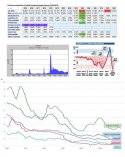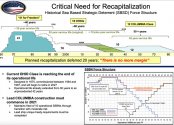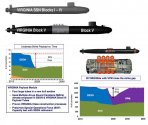Experts: U.S. Military Chip Supply Is Dangerously Low
If a war involving Taiwan were to break out in the next decade, the DoD’s ability to respond effectively would be challenged by the Russia-Ukraine War, competition from commercial chip buyers and an over-reliance on Asian semiconductor suppliers.
01.06.2023
The U.S. Department of Defense (DoD) will probably take years to wean itself from Asian chip supplies because of a dearth of investments in domestic production capacity, according to industry insiders and government observers.
Global chip shortages have impeded the ability of DoD contractors like Lockheed Martin and Raytheon to boost production of weapons used in the Russia-Ukraine War.
The DoD must also reckon with competition from commercial buyers for foundry wafers, as well as the military’s over-reliance on older chip architectures.
As a result, concerns are surfacing that the U.S. may have difficulty responding, for as many as 10 years, to
a war involving Taiwan—which is home to manufacturers that, ironically, supply chips used by the DoD.
Taiwan is at the center of rising tensions between the U.S. and China. On Dec. 25, China sent a record 47 aircraft across the median line in the Taiwan Strait, according to Taiwan’s Ministry of National Defense. That incursion came days after the U.S. passed the 2023 National Defense Authorization Act, which allows for up to $10 billion in security assistance to Taiwan over the next five years.
The DoD may need a decade to build a reliable domestic supply chain, according to Mike Burns, an electronics engineer who has founded chip companies like iDeal Semiconductor and Agere Systems.
The issue is how fast U.S.-based Intel can catch up with Taiwan Semiconductor Manufacturing Co. (TSMC), which makes Altera and Xilinx field programmable gate arrays (FPGAs) and other chips that the DoD uses in weapons systems like the F-35 fighter jet, missiles and command-and-control gear, he said.
“Maybe that’s a three-year effort,” he told EE Times. “I’m just saying that it’s many years.”
To be sure, TSMC more than tripled its overall investment in Phoenix, Ariz., to about $40 billion in December to make way for a second U.S. chip facility that’s set to start production at the 3-nm node in 2026. While Apple and AMD aim to buy chips from TSMC’s Arizona site, the fab isn’t likely to be a DoD supplier, Burns said.
“I don’t think TSMC would do that,” he said. “If you’ve seen their stance on American engineers, they don’t seem very pleased with them.”
TSMC has often said it aims to keep its most advanced production technology in Taiwan, where the world’s largest foundry makes more than 90% of its chips. The company last year began rolling out its first 3-nm chips in Taiwan—years ahead of the U.S.
TSMC has encountered a culture clash with some of the engineers it hired in the U.S. to work at the Arizona site. That challenge and TSMC’s focus on serving large customers like Apple and AMD will make Intel’s smaller foundry service a more likely fit as a DoD supplier, Burns noted.
“That will be up to Intel,” he said. “Intel Foundry Services can make application-specific integrated circuits (ASICs) that are one or two generations behind the process at TSMC. Maybe that makes up the difference.”
Years ago, Intel bought FPGA supplier Altera, which uses TSMC to make the programmable chips that are easily modified yet lag the performance of ASICs.
The DoD is forced to rely on FPGAs because it can’t find a large foundry like TSMC or Samsung to make custom ASICs for its weapons systems.
The
competition from commercial customers like Apple and AMD for foundry wafers has diminished the purchasing power of small buyers like the DoD. Even U.S.-based GlobalFoundries gives little priority to the DoD, Burns said.
“GlobalFoundries has a ton of commercial customers pushing for volume. We never know with an increase in military wafers: How long will that last? Usually they’re high cost, low volume, and they’re unpredictable in volume.”
The U.S. military relies on legacy, or older, chip architectures that aren’t widely available and often must be made in small, dedicated batches, Bryan Clark, a senior fellow with the Hudson Institute, told EE Times.
“When chip shortages occur, companies that make these chips can make more money building chips for appliances and cars,” he said. “If the DoD used more state-of-the-art chips with commercial architectures and adapted them through packaging or software, the U.S. military would be able to tap into the scale of commercial production and be less vulnerable to chip supply disruptions.”
China, which the U.S. has punished with recent chip export-control measures, faces supply chain issues of its own. The U.S. considers China a “strategic competitor” that’s a threat in tech domains like 5G telecommunications and AI.
“The PRC military already uses a significant fraction of commercially available chips, but they are completely dependent on U.S. and Western technology to build those chips, or the PRC military has to buy the chips from potential rivals like Japan or Taiwan,” Clark said. “The PRC military is therefore better able to weather supply disruptions, but less prepared to address supply cut-offs that occur for national security reasons.”
FPGAs lag ASICs
The DoD needs to reserve a certain amount of capacity for surges in demand like that created by the Ukraine War, Burns said. He proposed to the U.S. Congress three years ago that the U.S. government should subsidize a joint venture with an advanced fab like TSMC for dedicated DoD capacity. Small U.S. foundries like SkyWater can’t meet the DoD’s need for advanced chips, he added.
“As much as we use the SkyWaters of the world at 90 nm and 130 nm, we still need advanced compute, but we can’t get it,” Burns said. “No trusted fab does 5-nm compute. We tend to buy FPGAs and configure them in the U.S. where the configuration can be secret. But with any FPGA, you have a tradeoff of performance because a purpose-built ASIC is going to be faster.”
The DoD did not respond to a request for comment from EE Times.
Suppliers of weapons systems like Raytheon say chip shortages limit their ability to expand production.
“There is no magic formula in the supply chain to accelerate this,” Raytheon CEO Greg Hays said in a Dec. 7 interview with CNBC. “We’re working to do as much as we can to try and cut that lead time down. But there are thousands of components. Not surprisingly, chips are a key element in this equipment. We’re working with the DoD to find other alternatives, perhaps in terms of some of the suppliers.”
In its mid-October 2022 earnings call, Lockheed Martin said its sales this year will be little changed from last year. With continuing impacts from the Covid pandemic and supply chain challenges, the company expects a return to growth in 2024.
Raytheon and Lockheed Martin operate aging chip fabs in the U.S. that are on a list of trusted DoD suppliers.
...



